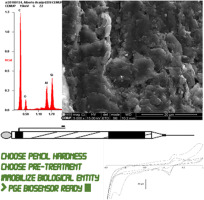Talanta ( IF 5.6 ) Pub Date : 2018-07-27 , DOI: 10.1016/j.talanta.2018.07.086 Álvaro Torrinha , Célia G. Amorim , Maria C.B.S.M. Montenegro , Alberto N. Araújo

|
Pencil leads have been increasingly used as electrode material in electrochemical applications. Commonly denominated as pencil graphite electrodes (PGE), they represent a viable alternative to other standard electrodes due to their comparable electrical properties but mainly for their low cost and availability, enabling disposable applications. In order to achieve the best analytical performance literature evidences the type of lead (hardness level) and electrode surface pre-treatment are critical to the envisaged application. The present review describes the use of PGE in biosensing analysis, more specifically those sensors comprising immobilized enzymes but also briefly referring nucleic acids and other biological entities. It lays an emphasis in the immobilization process of the biological entities while focusing in the analytical performance of each biosensor, mainly sensitivity, linear range and limit of detection as comparative criteria. This review also addresses the main characteristics and properties of PGEs as transducer material in the electrochemical field.
中文翻译:

基于铅笔状石墨电极的生物传感
铅笔芯已越来越多地用作电化学应用中的电极材料。通常被称为笔形石墨电极(PGE),由于它们具有可比的电性能,但它们可替代其他标准电极,但主要是因为它们的低成本和高可用性,可用于一次性应用。为了获得最佳的分析性能,文献证据表明铅的类型(硬度水平)和电极表面的预处理对于所设想的应用至关重要。本综述描述了PGE在生物传感分析中的用途,更具体地说,是那些包含固定化酶但还简要提及了核酸和其他生物实体的传感器。它着重于生物实体的固定过程,同时侧重于每个生物传感器的分析性能,主要是灵敏度,线性范围和检测极限作为比较标准。这篇综述还讨论了在电化学领域中作为换能器材料的PGE的主要特征和特性。











































 京公网安备 11010802027423号
京公网安备 11010802027423号